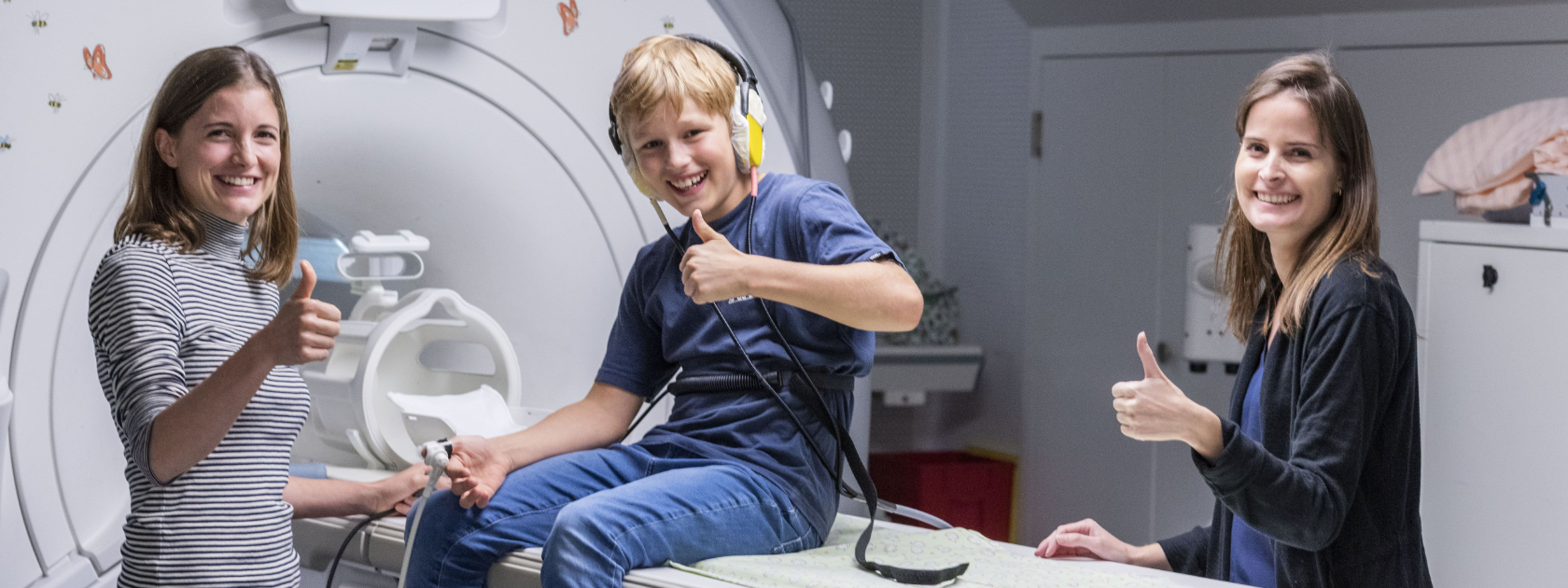Integrating human, animal, and clinical perspectives
A core aspect of our research is to relate animal to human learning, and to link learning to neural circuit function. Eventually, our goal is to translate mechanistic insights from basic research to the clinics. We want to improve developmental delay diagnosis and to design innovative treatment strategies.
Animal models are indispensable for dissecting circuit functions, but learning and cognitive capabilities differ between humans and animals. Thus, it is not straightforward to directly map animal behavior and circuit mechanisms onto human brain function and behavior. However, identifying shared learning-related processes across species and revealing their common characteristics is a great asset. We are developing tasks and computational models that can be conducted in parallel in mice, healthy humans, and patients. We use them to investigate multi-sensory learning, an important cognitive function that may be fundamentally disrupted in developmental disorders. Use of the same tasks and models in these parallel investigations makes it possible to detect the neural circuit mechanisms underlying behavioral deficits in patients and to study them at the circuit and molecular level in animals.
The ultimate goal is to translate new mechanistic insights about neural circuit function gained through coordinated animal and human research into the clinics by developing improved diagnostic tools and treatment strategies. Surprisingly, sensory and multi-sensory behaviors that require integrative circuit functions are typically not assessed during developmental delay diagnosis, even though they likely are disrupted in such patients and may even represent core symptoms. We thus plan to incorporate our new standardized multi-sensory behavioral assay into the standard test battery for developmental delay diagnosis. Further, the identification of the molecular and genetic mechanisms of impaired neural circuit development would help to counsel parents and health care professionals by predicting developmental trajectories and facilitate tailored therapeutic interventions.
New projects
NUMIS: NUmerosity in Dyscalculia and Autism: The Role of Multisensory Integration and Stress
We examine the multisensory integration of numerical information and the influence of stress on numerical performance in children and adults with developmental dyscalculia and ASD.
Research groups: Karin Kucian, Christian Ruff
More information following
NeCiMus - Neural circuit mechanisms underlying multisensory salience processing
In this study, we investigate neural circuit mechanisms underlying multisensory salience processing.
Research groups: Philippe Tobler, Christian Ruff
More information following
BIMA - Bridging the gap: Investigating multisensory and neurocognitive circuit mechanisms underlying symptom profiles and predicting therapy success in adolescents with autism spectrum disorder
We investigate multisensory and neurocognitive circuit mechanisms underlying different symptom profiles in adolescents with autism spectrum disorder. Further, we evaluate a therapeutic intervention addressing sensory oversensitivity and prediction of therapy success.
Research groups: Christian Ruff, Susanne Walitza
More information following
CONNECT: Investigating Neural and Behavioral Characteristics of Children with
Global Developmental Delays, Multisensory Deficits, and ASD Traits
This study explores how sensory processing difficulties in global developmental delay impact thinking and emotions.
Research groups: Michael von Rhein, Nora Raschle
More information following
The impact of sleep on sensory integration, cognitive function and emotion regulation in children with autism
This study investigates how sleep impacts learning and emotion regulation in children with autism spectrum disorder.
Research groups: Bea Latal, Reto Huber
More information following
Running projects
Functional brain network mechanisms underlying multisensory learning (FuncMechanism)
In this project, we developed tasks to assess multi-sensory learning in humans and combined
them with fMRI measurements in healthy adults. We want to identify brain areas involved in learning of multi-sensory associations.
Research groups: Christian Ruff, Fritjof Helmchen, Silvia Brem
Neural basis of multisensory learning and processing during child development (ChildBrainCircuits)
We adapt and apply the tests developed in adults to children with typical development and with developmental language disorders during behavioural and neuroimaging assessments.
We are currently looking for participantsMore information and registration
Research groups: Silvia Brem, Anita Rauch, Nora Raschle, Michael von Rhein, Christian Ruff
Neural origins of disrupted magnitude processing and risk taking in dyscalculia (NumRisk)
In this project, we are studying the neural origins of disrupted magnitude processing in dyscalculia.
We are currently looking for participants. For more information or registration, please contact us.
Research groups: Christian Ruff, Karin Kucian, Silvia Brem
Development and evaluation of an intervention for adolescents and adults with dyscalculia (SMILE)
In an interventional study, we aim to develop a support program and to evaluate its effectiveness regarding math performance and neuronal changes in the brain of adolescents and adults with dyscalculia.
We are looking for participants with dyscalculia (see flyer (PDF, 265 KB), in German) and without dyscalculia (see flyer (PDF, 600 KB), in German).
Research groups: Karin Kucian, Christian Ruff, Silvia Brem, Elisabeth Moser-Opitz (external collaborator, Institute of Education and DSN-ZH)
A 3D mesoscale atlas of intrathalamic inhibitory interneurons in the human brain
This project focuses on the creation of a new open-source digital 3D atlas that characterizes the distribution of intrathalamic inhibitory interneurons in human brain tissue.
Research groups: Andras Jakab, Fritjof Helmchen, Theo Karayannis, mesoSPIM and HDDA Platforms
Structural basis of mild developmental delay in the developing human brain connectome
In this project, we are establishing techniques to reveal human brain connectome features that may differ in patients with developmental delay.
Research groups: Andras Jakab, Bea Latal, Michael von Rhein, Valerio Mante
Completed projects
The impact of clinical risk and environmental resilience factors on brain circuits learning: A network connectivity analysis in adolescents with congenital heart disease
We are testing the effect of clinical risk and environmental factors on brain connectivity and learning.
Research groups: Bea Latal, Andras Jakab
The effect of early childhood and in-utero trauma on brain development, educational outcomes, and professional attainment: Large-scale evidence from the UK Biobank
Research groups: Christian Ruff, Valerio Mante, Platform SEED HDDA
The genetic contribution to mild neurodevelopmental impairments in congenital heart disease: direct or indirect effect
We identified genetic variants in a cohort of patients with congenital heart disease and developmental delay.
Research groups: Bea Latal, Anita Rauch
